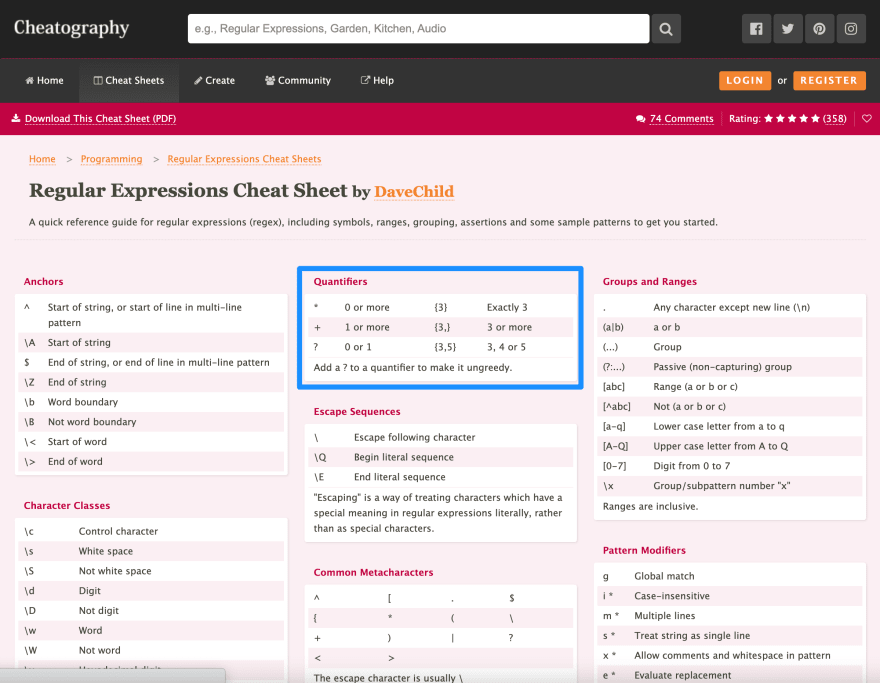This content originally appeared on DEV Community and was authored by Analogy | Absence | Example
Intro
I was recently doing a code challenge for a job interview that required me to strip out all nonalphabetic characters. "Ah! I should use Regular Expressions for this!" I thought in triumph, impressed that I even knew what regular expressions were. That fleeting moment of glory faded once I decided to brush up on regular expressions and landed on the encouragingly-named Regular Expressions Cheatsheet. I had no idea how to use it!
So, for people like me, here is a Cheatsheet for the Regular Expressions Cheatsheet, Part V: Quantifiers
What's an Quantifier?
A quantifier finds a sequence of characters to match. It also can be used to find a sequence of expressions to match, but I'm gonna keep it simple here and focus on sequences of characters.
Anatomy of a regular expression
- Forward slashes go on either end like so:
/something/ - Add
gfor "global" at the end to find every instance, like so:/something/g - Add
mto "multi line" to the beginning/end of each line, not just the beginning/end of each string, like/something/gor/something/gm
Quantifiers
* 0 or more instances of a character
-
ro*aris used in/ro*ar/to find the following: The lion said roar rooar roooar roooooooar! - Example on regex101.com
- Example in Javascript:
let sentence = "The lion said roar rooar roooar roooooooar!";
let regex = /ro*ar/;
let found = sentence.match(regex);
console.log(found); // [
'roar',
index: 14,
input: 'The lion said roar rooar roooar roooooooar!',
groups: undefined
]
+ 1 or more instances of a character
-
ro+aris used in/ro+ar/to find the following: The lion said roar rooar roooar roooooooar! - Example on regex101.com
- Example in Javascript:
let sentence = "The lion said roar rooar roooar roooooooar!";
let regex = /ro+ar/;
let found = sentence.match(regex);
console.log(found); // [
'roar',
index: 14,
input: 'The lion said roar rooar roooar roooooooar!',
groups: undefined
]
? 0 or 1 instance of a character
-
ro?aris used in/ro+ar/to find the following: The lion said roar rooar roooar roooooooar! - Example on regex101.com
- Example in Javascript:
let sentence = "The lion said roar rooar roooar roooooooar!";
let regex = /ro?ar/;
let found = sentence.match(regex);
console.log(found); // [
'roar',
index: 14,
input: 'The lion said roar rooar roooar roooooooar!',
groups: undefined
]
{N} N instances of a character
-
{3}is used in/ro{3}ar/to find the following: The lion said roar rooar roooar roooooooar! - Example on regex101.com
- Example in Javascript:
let sentence = "The lion said roar rooar roooar roooooooar!";
let regex = /ro{3}ar/;
let found = sentence.match(regex);
console.log(found); // [
'roooar',
index: 25,
input: 'The lion said roar rooar roooar roooooooar!',
groups: undefined
]
{N,} At least N instances of a character
-
{3,}is used in/ro{3,}ar/to find the following: The lion said roar rooar roooar roooooooar! - Example on regex101.com
- Example in Javascript:
let sentence = "The lion said roar rooar roooar roooooooar!";
let regex = /ro{3,}ar/;
let found = sentence.match(regex);
console.log(found); // [
'roooar',
index: 25,
input: 'The lion said roar rooar roooar roooooooar!',
groups: undefined
]
{N,M} Between N and M instances of a character
-
{2,4}is used in/ro{2,4}ar/to find the following: The lion said roar rooar roooar roooooooar! - Example on regex101.com
- Example in Javascript:
let sentence = "The lion said roar rooar roooar roooooooar!";
let regex = /ro{2,4}ar/;
let found = sentence.match(regex);
console.log(found); // [
'rooar',
index: 19,
input: 'The lion said roar rooar roooar roooooooar!',
groups: undefined
]
This content originally appeared on DEV Community and was authored by Analogy | Absence | Example
Analogy | Absence | Example | Sciencx (2021-05-10T17:52:30+00:00) Cheatsheet for the Regex Cheatsheet, Part V: Quantifiers. Retrieved from https://www.scien.cx/2021/05/10/cheatsheet-for-the-regex-cheatsheet-part-v-quantifiers/
Please log in to upload a file.
There are no updates yet.
Click the Upload button above to add an update.

